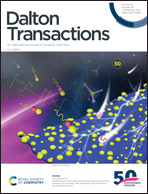Benchmarking magnetic and spectroscopic properties on highly stable 3d metal complexes with tuneable bis(benzoxazol-2-yl)methanide ligands†
Abstract
Two series a and b of 3d metal based complexes 1–4 [MII{(4-R-NCOC6H4)2CH}2], (with M = Mn (1), Fe (2), Co (3), Ni (4) and R = H (a) or Me (b)) were synthesised and structurally characterized. The complexes were found to crystallize differently depending on the dication ionic radius and the ligand substitution. All complexes showed remarkable X-ray diffraction resolution that will allow further advanced diffraction experiments. Subsequently, their spectroscopic and magnetic properties were analysed. Complexes 3a and 3b notably show slow magnetic relaxation of their magnetization and represent simple model systems relaxing through a phonon-bottleneck process (3a) or as a field-induced single-molecule magnet (3b, Ueff = 45.0 cm−1). Remarkably, the magnetic anisotropy in the manganese complex 1b results in induced slow magnetic relaxation. The influence of the dual 4-methylation of the ligands was investigated and found to generate important variations in the physical features of the corresponding complexes. Accessible via one-pot synthesis, these are highly robust against oxidation and moisture. Through smart ligand engineering, they represent stable and tuneable compounds for benchmarking purposes through standard and less-standard characterization methods.



 Please wait while we load your content...
Please wait while we load your content...